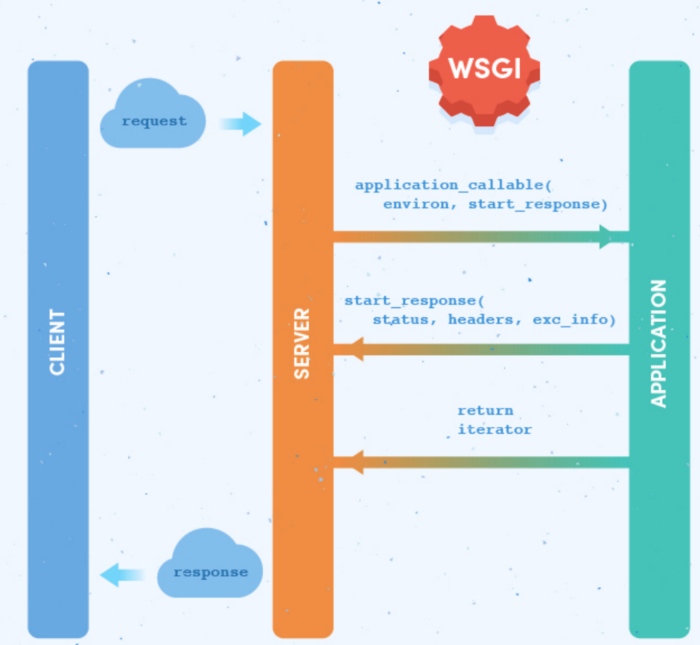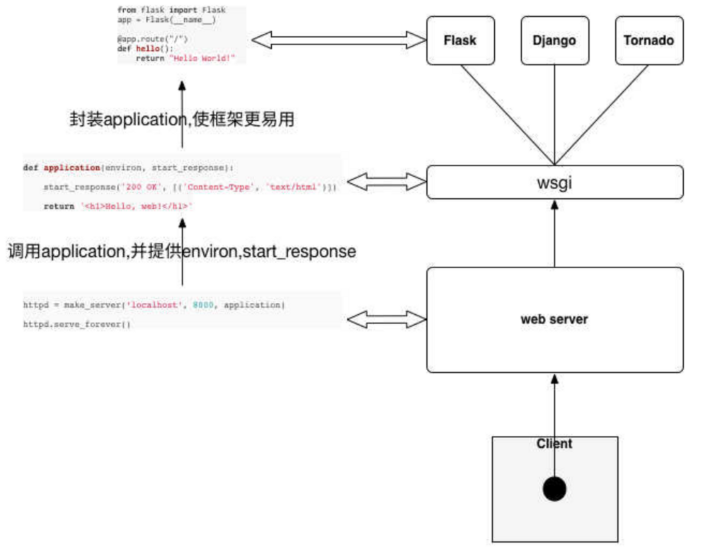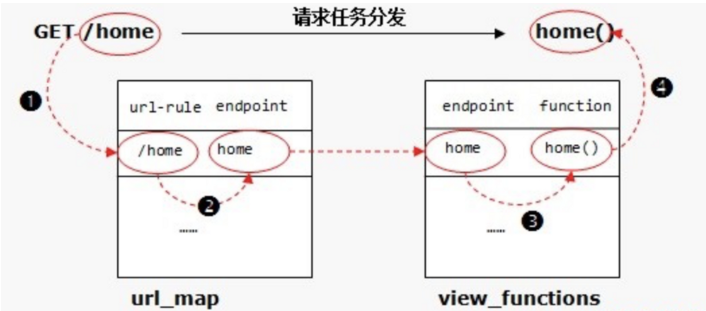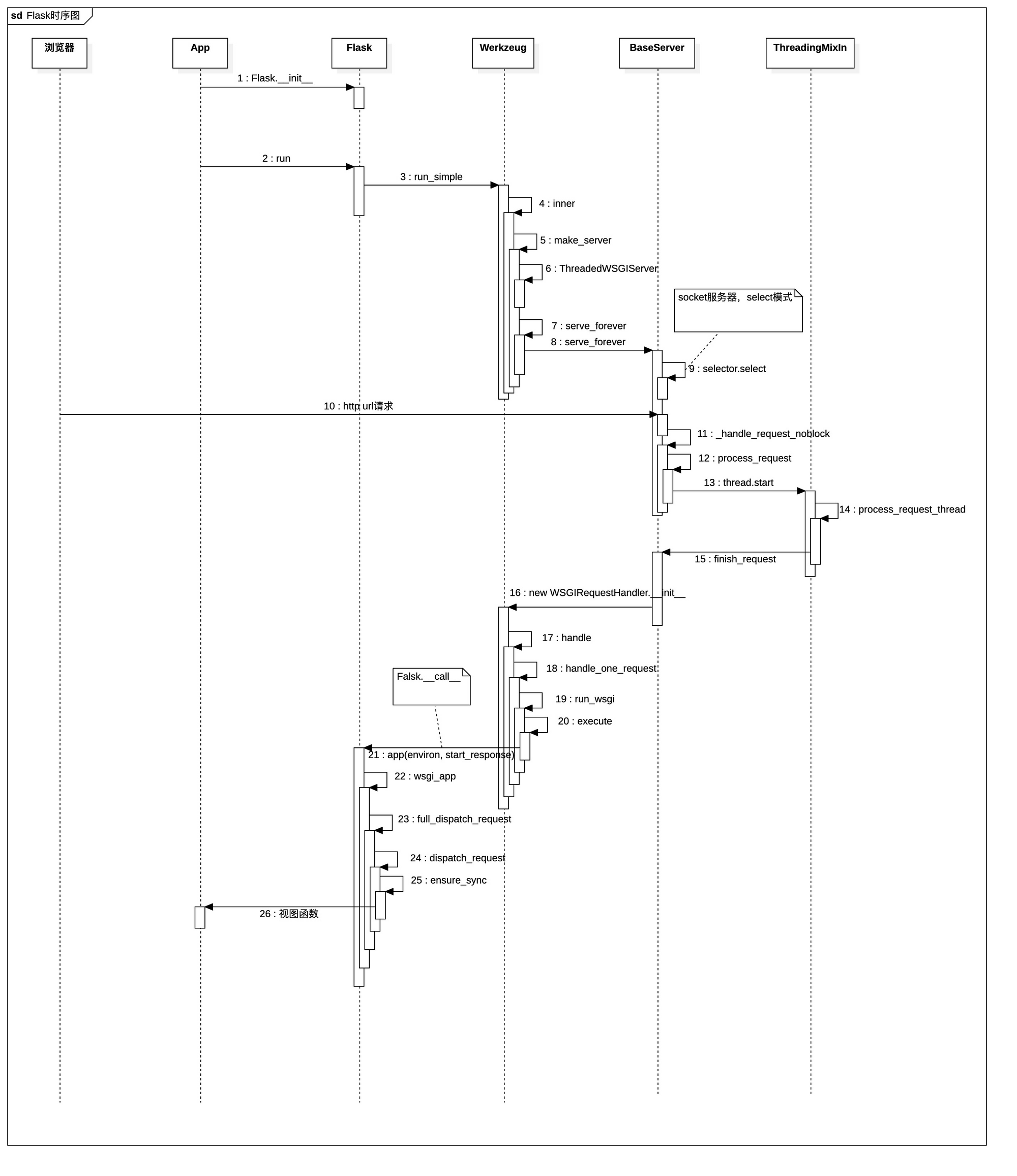工具集
flask
203_flask
PEP 3333
Python Web Server Gateway Interface v1.0.1:https://peps.python.org/pep-3333/
https://juejin.cn/post/6844903686905282568
WSGI
WSGI,全称 Web Server Gateway Interface,或者 Python Web Server Gateway Interface ,是基于 Python 定义的 Web 服务器和 Web 应用程序或框架之间的一种简单而通用的接口。
WSGI接口的作用是确保HTTP请求能够转化成python应用的一个功能调用,这也就是Gateway的意义所在,网关的作用就是在协议之前进行转换 。
WSGI接口中有一个非常明确的标准,每个Python Web应用必须是可调用callable的对象且返回一个iterator,并实现了app(environ, start_response) 的接口,server 会调用 application,并传给它两个参数:environ 包含了请求的所有信息,start_response 是 application 处理完之后需要调用的函数,参数是状态码、响应头部还有错误信息。引用代码
WEB应用的处理请求的整体流程:
用户操作操作浏览器发送请求;
请求转发至对应的web服务
web服务器 *将请求转交给* web应用程序 web应用将请求结果返回给web服务器,由web服务器返回用户响应结果
浏览器收到响应,向用户展示
可以看到,请求时Web服务器需要和web应用程序进行通信,但是web服务器有很多种啊,Python web应用开发框架也对应多种啊,所以WSGI应运而生,定义了一套通信标准。试想一下,如果不统一标准的话,就会存在Web框架和Web服务器数据无法匹配的情况,那么开发就会受到限制,这显然不合理的。
WSGI的标准或规范是?
web服务器在将请求转交给web应用程序之前,需要先将http报文转换为WSGI规定的格式。
WSGI规定,Web程序必须有一个可调用对象,且该可调用对象接收两个参数,返回一个可迭代对象:
environ:字典,包含请求的所有信息
start_response:在可调用对象中调用的函数,用来发起响应,参数包括状态码,headers等
实现一个简单WSGI服务
首先,我们编写一个符合WSGI标准的一个http处理函数:
Text Only
接下来,我们需要一个服务器启动WSGI服务器用来处理验证,使用Python内置的WSGI服务器模块wsgiref,编写server.py
Text Only
通过实现一个简单的WSGI服务,我们可以看到:通过environ可以获取http请求的所有信息,http响应的数据都可以通过start_response加上函数的返回值作为body。
Flask与WSG
Flask中的程序实例app就是一个可调用对象,我们创建app实例时所调用的Flask类实现了call 方法,call 方法调用了wsgi_app()方法,该方法完成了请求和响应的处理,WSGI服务器通过调用该方法传入请求数据,获取返回数据:
Text Only
WerkZeug
Werkzeug是一个WSGI工具包。WSGI是一个web应用和服务器通信的协议,web应用可以通过WSGI一起工作。一个基本的”Hello World”WSGI应用看起来是这样的:
Text Only
上面这小段代码就是WSGI协议的约定,它有一个可调用的start_response 。environ包含了所有进来的信息。 start_response用来表明已经收到一个响应。 通过Werkzeug,我们可以不必直接处理请求或者响应这些底层的东西,它已经为我们封装好了这些。
请求数据需要environ对象,Werkzeug允许我们以一个轻松的方式访问数据。响应对象是一个WSGI应用,提供了更好的方法来创建响应。如下所示:
Text Only
路由
注册路由
flassk路由的作用是为不同的HTTP URL注册不同的视图函数,框架提供了两种注册路由的方式:
方式1:通过@route装饰器,在Scaffold类中实现
方式2:通过add_url_rule函数,在Scaffold中定义,Flask类继承Scaffold后对该函数重写
方式1源码如下:其本质也是通过调用方式2,只是相较而言,装饰器的方式让代码更优雅
Text Only
方式2源码如下:
Text Only
Endpoint
需s要注意的是, 框架中请求任务的分发并不是直接从用户请求的URL一步定位到视图函数, 两者之间还隔着一个访问点endpoint。Flask内部使用两张表维护路由:
url_map :维护URL规则和endpoint的映射
view_functions :维护endpoint和视图函数的映射
如下图,以用户访问URL/home为例,Flask将首先利用url_map找到所请求URL对应的 endpoint,即访问点home,然后再利用view_functions表查找home这个访问点对应的视图函数,最终匹配到函数home()
关于访问点的命名规则有两种:
默认访问点:当我们使用route装饰器注册路由时,默认使用被装饰函数的函数名作为访问点;
自定义访问点:可以在使用route装饰器或调用add_url_rule()方法注册路由时,使用endpoint关键字参数改变这一默认行为;
Python @app . route ( '/home' , endpoint = 'whocare' )
def home ():
pass
通过endpoint关键字自定义路由对应的访问点,路由表对应规则即如下图:
为什么需要endpoint做中间层?
Text Only
因此,endpoint这种中间层的存在可以方便代码解耦,单独修改url不会影响现有的跳转实现。
endpoint源码如下,定义在Scaffold类中
Text Only
静态目录路由
关s于静态目录路由的配置方式也有两种:
默认静态目录路由:当创建应用实例时,Flask将自动添加一条静态目录路由,其访问点始终被设置为static,URL规则默认被设置为/static,本地路径默认被设置为应用文件夹下的static子文件夹。例如如下目录,那么启动应用后就可以通过URL/static/main.css访问static文件夹下的main.css了。
Text Only
自定义静态目录路由 :可以在创建应用对象时使用关键字参数static_folder改变 默认的静态文件夹。例如,你的静态文件都存放在应用下的assets目录下, 那么可以按如下的方式创建应用对象:
Text Only
改变默认的URL规则 : 如果不喜欢静态目录URL/static,也可以在创建应用 对象时使用关键字参数static_url_path换一个别的名字。下面的示例中,将应用下的assets文件夹注册为静态目录/assets:
Text Only
启动过程 以如下flask程序介绍框中整体流程。
Text Only
时序图
服务器 werkzeug中BaseWSGIServer类继承自Python自带http模块实现服务端:
Text Only
参考资料
最后更新:
2024-04-14




